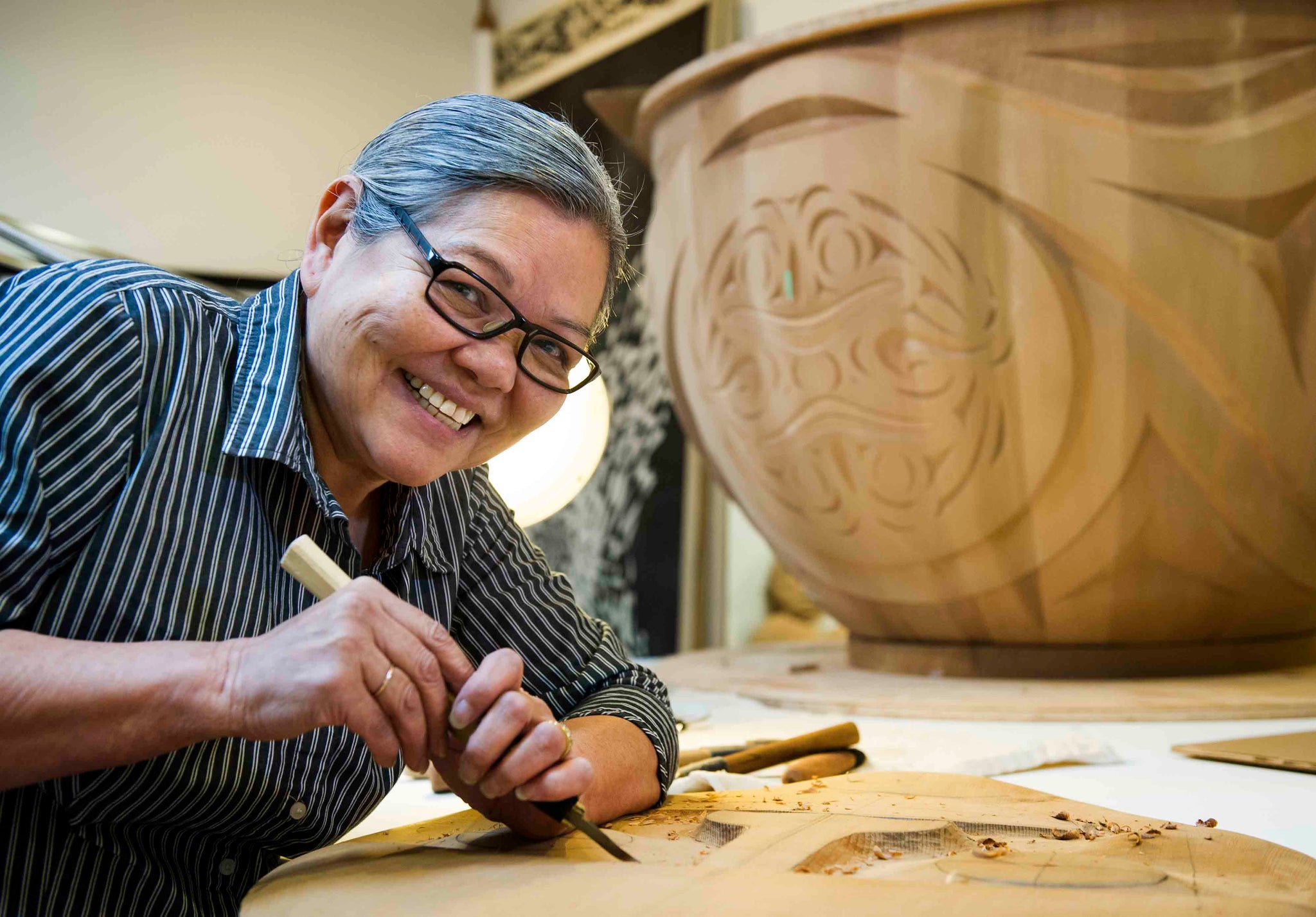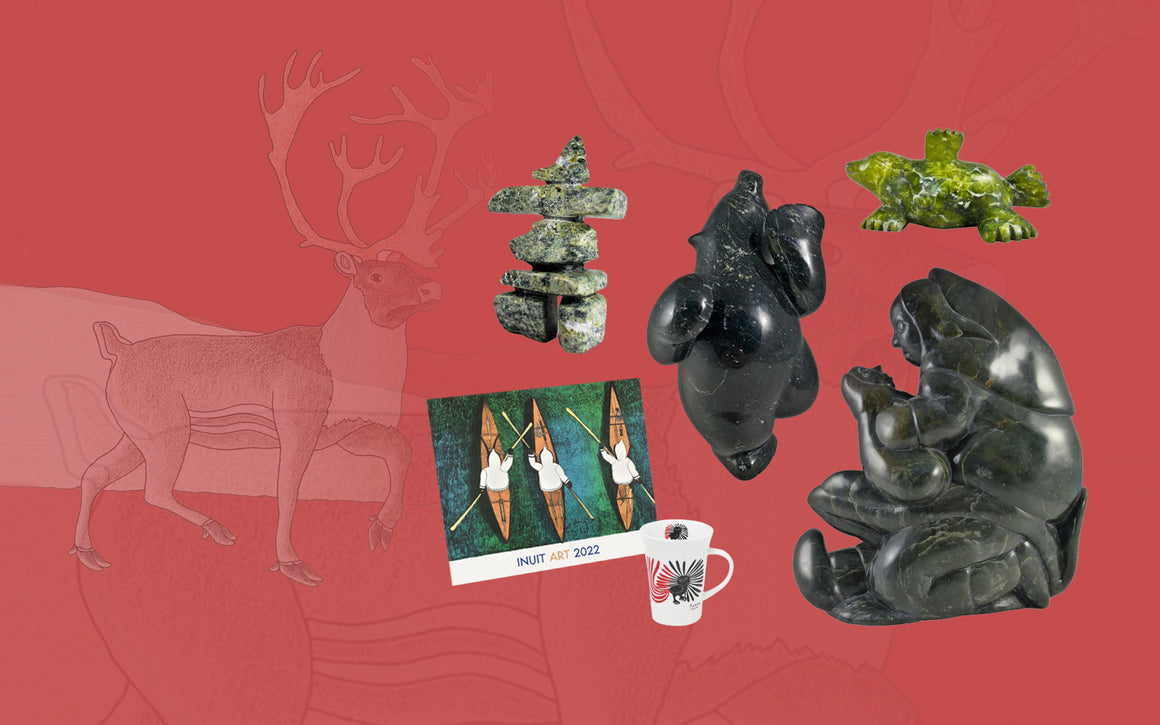
Susan Point Biography

SUSAN POINT, E’ixwe’tiye – Coast Salish Artist
The artist Susan Point is a member of the Coast Salish First nation. The ancestral territory of the Musqueam community she is part of, is where we now find the Vancouver Urban area.
Susan Point was born on april 5th, 1952 on the Kwakwaka’wakw territory while her family was there for the salmon fishing season. She then grew up on the Musqueam territory.
Unfortunately, as a lot of indigenous children everywhere in Canada, Susan Point was sent to residential school for 5 years after elementary school, she said it was “a heartbreaking experience”. Later she began to work at 16 years old at a cannery and then at the Musqueam band council.
Susan Point mother, Edna Grant, was one of the last Musqueam woman to know how to make cedar-root coiled basket. This made it possible to maintain a link between past creative practices and present artistic\creative practices because it inspired Susan Point’s creations.
Susan Point artistic pathway started in the 80’s.There were not a lot of Salish style artistic production at that time : she was a precursor. Her artistic inquiry began in 1981 when she took a jewellery-making course offered by the Vancouver Community College for First nations students. At the same period, she discovered Salish people art through the serigraphs of Stan Greene. She was then working with an anthropologist to know Salish aesthetic better through the artefact of the Museum of Anthropology at the University of British Colombia.
She started her artistic creation with graphic art, in two dimensions, her first print is called Salmon and was produced in 1981. She later adapted the Salish graphic style to non-traditional materials like glass or bronze which brought her success.
In this male dominated sector, she became a unique and essential source of inspiration for a new generation of artists and specially women.
During her career Susan Point’s art has evolved a lot by experimenting. That way she developed a mastering of serigraph technics while she was doing her first prints at home, with help from her children. She always completed this self-learning by contacting experts each time she wanted to go further. That is how she developped her work on glass and on wood.
Then, one year after her introduction to red cedar she carved her first house post (in the round). She realized it for the First Nations House of Learning on the campus of the British-Colombia University. She also produced a lot of carving in the urban environment in Seattle.
Her colour palette is unique among the Northwest Coast artists. She was criticized for that at first but now this contribute to build her unique style! It could have a link with the influence she received from an interior design course.
She sometimes include patterns from the more feminine Salish universe, such as weaving patterns or the ones we find more often on feminine utensils.
Today, Susan Point is teaching art, for the Emily Carr Institute of Art and Design in Vancouver, amongst others. She received an honorary art PH.D. from the University of Victoria in 2000 for her contribution to the world of the arts.
Susan Point still live on her people territory, near what we call today the Fraser river.
SUSAN POINT, E'ixwe'tiye
Artiste Coast Salish
L'artiste Susan Point fait partie du peuple Musqueam dont le territoire ancestral se trouve au niveau de l'actuelle zone urbaine de Vancouver. Le peuple Musqueam fait partie du groupe plus large des Premières nations Coast Salish.
Susan Point, née le 5 avril 1952 à Alert Bay, en territoire Kwakwaka'wakw alors que sa famille était là pour la saison de pêche au saumon, a grandi sur le territoire Musqueam.
Comme malheureusement beaucoup d'enfants autochtones partout au Canada, Susan Point a été envoyée au pensionnat pendant 5 ans après l'école primaire ce qui a été selon ses propres mots “a heartbreaking experience”. Elle a ensuite commencé à travailler à 16 ans dans une usine puis au conseil de bande local.
La mère de Susan Point, Edna Grant, était une des dernières femmes Musqueam à savoir fabriquer les paniers enroulés de racine de cèdre (cedar-root coiled basket). Ceci a permis de faire un lien entre les pratiques artisanales passées et les pratiques artistiques/artisanales présentes puisque cette pratique a contribué à inspirer les œuvres de Susan Point.
Le cheminement artistique de Susan Point a débuté dans les années 80. Il y avait peu de production artistique de style Salish à l'époque : elle a été une précurseure. Sa réflexion artistique a démarré en 1981 après qu'elle ait participé à un cours de joaillerie offert par le Vancouver Community College aux étudiant.e.s des Premières nations. À la même époque, elle découvre l'art du peuple Salish à travers les sérigraphies de Stan Greene. Elle travaille alors également avec un anthropologue pour mieux connaitre l'esthétique Salish via les artéfacts du Museum of Anthropology de l'Université de Colombie-Britannique.
Elle a commencé sa création artistique en pratiquant les arts graphiques, sur 2 dimensions, sa première impression s'intitule Salmon et date de 1981. Elle a plus tard adapté le style graphique Salish à des matériaux non-traditionnels comme le verre ou le bronze ce qui lui a apporté sa part de succès.
Dans ce milieu dominé par les artistes hommes, elle est devenue une source d'inspiration unique et nécessaire pour les artistes de la nouvelle génération et en particulier les femmes.
Tout au long de sa carrière Susan Point a beaucoup évolué en faisant des expérimentations. Elle a ainsi notamment développé une maîtrise particulière des techniques de sérigraphie alors qu'elle faisait ses premières impressions dans sa maison, aidée de ses enfants. Elle a toujours complété cet auto-apprentissage en allant chercher une personne d'expérience chaque fois qu'elle voulait aller plus loin. C'est ainsi qu'elle a développé son travail sur le verre et sur le bois.
Ainsi, un an après son introduction au cèdre rouge elle a sculpté sa première sculpture de totem dans un tronc d'arbre d'une hauteur de 3,6 m. Elle l'a réalisé pour la First Nations House of Learning sur le campus de l'université de Colombie-Britannique. Elle a également réalisé de nombreuses sculptures en milieu urbain à Seattle.
Sa palette de couleurs est unique dans le milieu des artistes “Northwest Coast” elle a été critiqué pour ça par le passé mais cette particularité contribue aujourd'hui à son style unique ! Ceci pourrait avoir un lien avec l'influence qu'elle a reçue de cours de design d'intérieur.
Notons qu'elle intègre parfois des motifs plutôt associés à l'univers féminin Salish, comme des motifs de tissages ou que l'on trouve habituellement sur des ustensiles féminins.
Susan Point est aujourd'hui aussi enseignante en art, par exemple pour le « Emily Carr Institute of Art and Design » à Vancouver. Elle a reçu un doctorat honorifique en arts de l'université de Victoria en 2000 pour sa contribution au monde de l'art.
Susan Point vit encore aujourd'hui sur le territoire de son peuple, au bord de ce qu'on appelle aujourd'hui la rivière Fraser.
REFERENCES
“Susan Point. Coast Salish Artist” Ed by Gary Wyatt.
“Susan Point. Works on paper” Dale Croas, Susan Point, Gary Wyatt.



